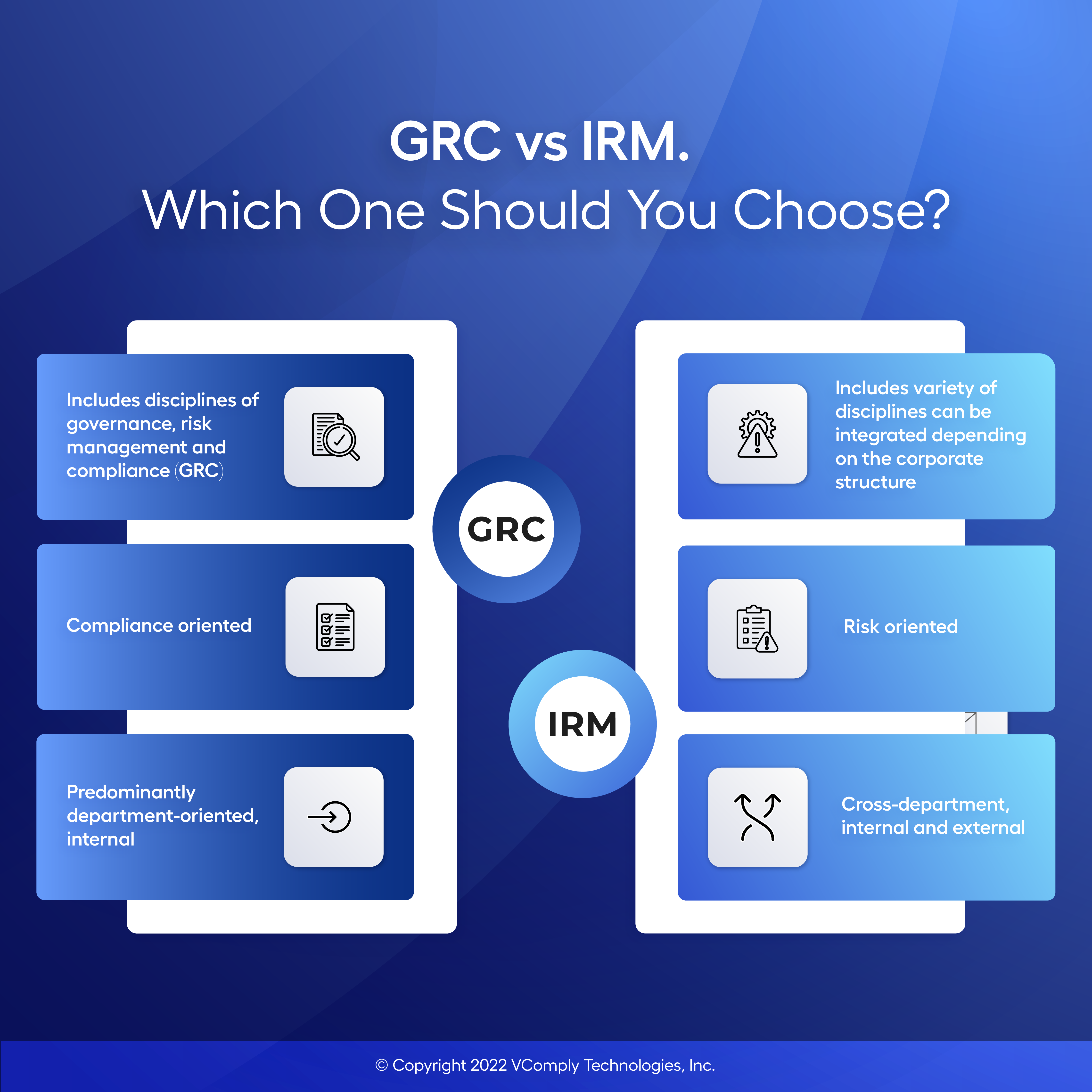What is the difference between GRC and Integrated Risk Management?
Since the beginning of business whether they knew it or not organizations have always been analyzing risk and implementing mitigation procedures. It wasn’t until 2002 when Michael Rasmussen and OCEG finally defined the field of risk management and coined the term GRC (governance, risk, and compliance). The concept was revolutionary, in a time when the world of business was becoming ever-more complex the field of thought known as GRC outlined and defined the interconnectivity of common areas of risk and established methods of prevention.

Over a decade later the management consulting company Gartner devised their own method of GRC calling it IRM (integrated risk management) in 2017. Whether it be GRC or IRM organizations have begun to realize that having either one is an absolute necessity to achieve business continuity and future success.
Key takeaways (TL;DR)
- Understand the difference between GRC and Integrated Risk Management (IRM) for business continuity.
- Learn the origins of GRC in financial compliance and how IRM integrates enterprise-wide risk.
- Discover how GRC and IRM approaches differ in scope and methodology but share the same goal.
- See why organizations benefit from either GRC or IRM through improved risk visibility and communication.
- Explore how VComply helps streamline both GRC and IRM processes for effective compliance and risk management.
Organizations and risk management teams alike may be wondering what is the difference or which is better. Unfortunately, the answer is not black and white, many experts including Michael Rasmussen himself would argue that GRC and Integrated Risk Management are nearly identical to one another with the only difference being the name. Upon initial research, this does appear to be the case, that GRC and IRM are two sides of the same coin, however, within the space there are some subtle differences that can be identified.
What is GRC? What is Risk Management? What’s their History?
GRC began in the financial sector and dealt mainly with financial reporting and audit management. The key aspect of GRC that set it aside from previous risk management strategies is the implementation of software assistance and the mitigating of spreadsheets. GRC then spread into other areas such as compliance and later ESG (environmental, social, governance). The new goal of GRC is to ensure that risk and compliance needs, whatever they are, are fully automated to improve agility and efficiency. IRM was created to seek an integrated approach to risk management ensuring that information is easily shared between different departments. Gartner also introduced the Magic Quadrant as part of their evaluation services that initially began evaluating GRC providers. While IRM may seem like the new age of GRC focusing on integrating various forms of risk management under one roof, the differences sometimes seem more subtle than that.
GRC vs Integrated Risk Management
As previously mentioned GRC’s origins began in the financial sector and dealt largely with compliance obligations. This trend has largely continued as much of what risk management means to today’s organizations is mitigating the risk of compliance failures. Regulatory requirements have expanded significantly and now encompass categories such as cybersecurity, data privacy, environmental obligations, AML, etc. GRC, if anything, has been criticized for being too compliance focused whereas IRM specializes in risk mitigation whether it be third-party or environmental hazards.
Things get confusing when looking at the world of Integrated Risk Management or Governance, Risk, and Compliance because risk and compliance work hand in hand with one another. Compliance obligations lead to potential risks, and when identifying risks organizations will find that a significant amount of them are related to compliance. Governance, risk, and compliance are not separate entities but should rather be treated as an interconnected web of business responsibility. Therefore to argue that GRC focuses on compliance and IRM focuses on risk cannot be true. Rather the difference appears to be how each one examines the interconnectedness.
GRC, as the name suggests, takes a wider approach to the business environment by understanding that organizations of different kinds require various solutions. Some organizations may be at more risk of compliance violations whereas others are at risk of cybersecurity breaches. GRC outlines an overall encompassing approach to find solutions for organizations no matter the size or market.
IRM does the same but through a different avenue. IRM takes a narrow approach in which the goal is the process of identifying risks and developing solutions to mitigate risks from there. These risks oftentimes are compliance-based, or maybe arise from cybersecurity concerns, but all are risks nonetheless.
Conclusion
The difference between IRM and GRC appears to not be the outcome but rather the means of getting there. GRC has created a system in which an interconnected network of roles and responsibilities must all coincide and communicate with one another to achieve effective and efficient risk mitigation procedures whereas IRM defines risks affecting a particular organization and then enforces collaboration among relevant parties to ensure that the risk is effectively mitigated.
So now you may be wondering which school of thought should organizations abide by. And the truthful answer is either. GRC has been around longer and generally encompasses more aspects than that of IRM, but perhaps an organization would rather have a more focused approach to specific risks. Whichever you choose the important takeaway is that in order to achieve success within the world of GRC organizations must have complete visibility of risks threatening the organization and must ensure clear communication throughout the entirety of the organization.
Discover what makes VComply a top G2 high performer in the GRC platform category. Book your demo now and explore its robust capabilities.
